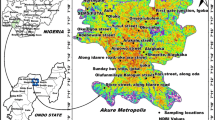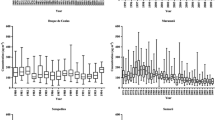Abstract
It is now irrefutable that air pollution caused by large amounts of Total Suspended Particulates (TSP) and respiratory particulates or Particulate Matter less than 10 μm in aerodynamic diameter (PM10) has numerous undesired consequences on human health. Air quality degradation far from the African continent, in the US and in Europe, caused by high concentrations of African dust, is seen as a major threat even though most of these countries are very distant from the Sahara. Surprisingly, no estimates of TSP or PM10 levels near the Saharan dust source are available. Based on horizontal visibility observations which are reduced by the presence of dust in the atmosphere, TSP and PM10 levels are estimated throughout the year 2000 at Nouakchott-Airport, Mauritania, using relations found in the literature. It appears that concentrations of particles are significant both in terms magnitude and frequency, as the 24-hour PM10 thresholds established by the US EPA National Ambient Air Quality Standards and the EU Limits Values for Air Quality were exceeded 86 and 137 times, respectively. The average annual concentration is far above air quality standards and estimated at 159 μg m−3 for TSP and 108 μg m−3 for PM10. These very high particulate levels are likely to represent an important public health hazard and should be considered as a major environmental risk.
Similar content being viewed by others
References
Alpert, P., & Ganor, E. (2001). Sahara mineral dust measurements from TOMS: comparison to surface observations over the Middle East for the extreme dust storm, March 14–17, 1998. Journal of Geophysical Research, 106 18275–18286.
Baldasano, J.M., Valera, E., & Jiménez, P. (2003). Air quality data from large cities. The Science of the Total Environment, 307 141–165.
Ben Mohamed, A., Frangi, J.P., Fontan, J., & Druilhet, A. (1992). Spatial and temporal variations of atmospheric turbidity and related parameters in Niger. Journal of Applied Meteorology, 31 1286–1294.
Bielders, C.L., Alvey, S., & Cronyn, N. (2001). Wind erosion: the perspective of grass-roots communities in the Sahel. Land Degradation and Development, 12 57–70.
Black, R.E., Morris, S.S., & Bryce, J. (2003). Where and why are 10 million children dying every year? Lancet, 361 2226–2234.
Callot, Y., Marticorena, B., & Bergametti, G. (2000). Geomorphologic approach for modelling the surface features of arid environments in a model of dust emissions: applications to the Sahara desert. Geodinamica Acta, 13 245–270.
Chen, Y.S., Sheen, P.C., Chen, E.R., Liu, Y.K., Wu, T.N., & Yang, C.Y. (2004). Effects of Asian dust storms events on daily mortality in Taipei, Taiwan. Environmental Research, 95 151–155.
Chung, Y.S., Kim, H.S., Dulam, J., & Harris, J.: 2003a. On heavy dustfall observed with explosive sandstorms in Chongwon-Chongju, Korea in 2002. Atmospheric Environment, 37 3425–3433.
Chung, Y.S., Kim, H.S., Park, K.H., Jhun, J.G., & Chen, S.J.: 2003b. Atmospheric loadings, concentrations and visibility associated with sandstorms: satellite and meteorological analysis. Water, Air, and Soil Pollution, Focus, 3 21–40.
D’Almeida, G.A. (1986). A model for Saharan dust transport. Journal of Climate and Applied Meteorology, 25 903–916.
Draxler, R.R., Gillette, D.A., Kirkpatrick, J.S., & Heller, J. (2001). Estimating PM10 air concentrations drom dust storms in Iraq, Kuwait and Saudi Arabia. Atmospheric Environment, 35 4315–4330.
Fang, X., Xie, Y., & Li, L. (2003). Effects of duststorms on the air pollution in Beijing. Water, Air, and Soil Pollution, Focus, 3 93–101.
Gillies, J.A., Nickling, W.G., & McTainsh, G.H. (1996). Dust concentrations and particle-size characteristics of an intense dust haze event: inland delta region, Mali, West Africa. Atmospheric Environment, 30 1081–1090.
Ginoux, P., Prospero, J.M., Torres, O., & Chin, M. (2004). Long-term simulation of global dust distribution with the GOCART model: correlation with North Atlantic Oscillation. Environmental Modelling & Software, 19 113–128.
Griffin, D.W., & Kellogg, C.A. (2004). Dust storms and their impact on ocean and human health: dust in earth’s atmosphere. Ecohealth, 1 284–295.
Gyan, K., Henry, W., Lacaille, S., Laloo, A., Lamsee-Ebanks, C., McKay, S., Antoine, R.M., & Monteil, M.A. (2005). African dust clouds are associated with increased paediatric asthma accident and emergency admissions on the Caribbean island of Trinidad. International Journal of Biometeorology, 49 371–376.
Kellogg, C.A., Griffin, D.W., Garrison V.H., Peak K.K., Royall N., Smith R.R., & Shinn, E.A. (2004). Characterization of aerosolized bacteria and fungi from desert dust events in Mali, West Africa. Aerobiologia, 20 99–110.
Kim, K.W., Kim, Y.J., & Oh, S.J. (2001). Visibility impairment during Yellow Sand periods in the urban atmosphere of Kwangju, Korea. Atmospheric Environment, 35 5157–5167.
Lancaster, N. (1996). Preface: response of aeolian processes to global climate change. Geomorphology, 17 1–2.
Marticorena, B., Bergametti, G., Aumont, B., Callot, Y., N’Doumé, C., & Legrand, M. (1997). Modeling the atmospheric dust cycle: 2. Simulation of Saharan dust sources. Journal of Geophysical Research, 102 4387–4404.
Middleton, N.J., & Goudie, A.S. (2001). Saharan dust: sources and trajectories. Transactions of the Institute of British Geographers, 26 165–181.
O’Hara, S.L., Wiggs, G.F.S., Mamedov, B., Davidson, G., & Hubbard, R.B. (2000). Exposure to airborne dust contaminated with pesticide in the Aral Sea region. Lancet, 355 627–628.
Ozer, P. (2000). Les lithométéores en région sahélienne: un indicateur climatique de la désertification. GEO-ECO-TROP, 24 1–317.
Ozer, P. (2002). Dust variability and land degradation in the Sahel. BELGEO, 2 195–209.
Ozer, P. (2005). Estimation de la pollution particulaire naturelle de l’air en 2003 à Niamey (Niger) à partir de données de visibilité horizontale. Environnement, Risques & Santé, 4 43–49.
Papastefanou, C., Manolopoulou, M., Stoulos, S., Ioannidou, A., & Gerasopoulos, E. (2001). Coloured rain dust from Sahara desert is still radioactive. Journal of Environmental Radioactivity, 55 109–112.
Prospero, J.M. (1999). Long-term measurements of the transport of African mineral dust to the southeastern United States: Implications for regional air quality. Journal of Geophysical Research, 104 15917–15927.
Prospero, J.M., Blades, E., Mathison, G., & Naidu, R. (2005). Interhemispheric transport of viable fungi and bacteria from Africa to the Caribbean with soil dust. Aerobiologia , 21 1–19.
Prospero, J.M., Ginoux, P., Torres, O., Nicholson, S.E., & Gill, T.E. (2002). Environmental characterization of global sources of atmospheric soil dust identified with the NIMBUS 7 Total Ozone Mapping Spectrometer (TOMS) absorbing aerosol product. Review of Geophysics, 40 1002, doi: 10.1029/2000RG000095.
Rajkumar, W.S., & Chang, A.S. (2000). Suspended particulate matter concentrations along the East-West Corridor, Trinidad, West Indies. Atmospheric Environment, 34 1181–1187.
Rodriguez, S., Querol, X., Alastuey, A., Kallos, G., & Kakaliagou, O. (2001). Saharan dust contributions to PM10 and TSP levels in southern and eastern Spain. Atmospheric Environment, 35 2433–2447.
Rodriguez, S., Querol, X., Alastuey, A., Viana, M., & Mantilla, E. (2003). Events affecting levels and seasonal evolution of airborne particulate matter concentrations in the western Mediterranean. Environmental Science & Technology, 37 216–222.
Romieu, I., Samet, J.M., Smith, K.R., & Bruce, N. (2002). Outdoor air pollution and acute respiratory infections among children in developing countries. Journal of Occupational and Environmental Medicine, 44 640–649.
Rosenfeld, D., Rudich, Y., & Lahav, R. (2001). Desert dust suppressing precipitation: a possible desertification feedback loop. Proceeding of the National Academy of Sciences, 98 5975–5980.
Ryall, D.B., Derwent, R.G., Manning, A.J., Redington, A.L., Corden, J., Millington, W., Simmonds, P.G., O’Doherty, S., Carslaw, N., & Fuller, G.W. (2002). The origin of high particulate concentrations over the United Kingdom, March 2000. Atmospheric Environment, 36 1363–1378.
Salvador, P., Artíñano, B., Alonso, D.G., Querol, X., & Alastuey, A. (2002). Identification and characterisation of sources of PM10 in Madrid (Spain) by statistical methods. Atmospheric Environment, 38 435–447.
Smith, R.K., Corvalán, C.F., & Kjellström, T. (1999). How much global ill health is attributable to environmental factors? Epidemiology, 10 573–584.
Tegen, I., & Fung, I. (1995). Contribution to the atmospheric mineral aerosol load from land surface modification. Journal of Geophysical Research, 100 18707–18726.
US EPA (1999). Guideline for reporting of daily air quality — Air Quality Index (AQI). Office for Air Quality Planning and Standards, United States Environmental Protection Agency, North Carolina, USA. http://www.epa.gov/ttn/-oarpg/t1/memoranda/rg701.pdf. Last accessed August, 27 2005.
Vautard, R., Bessagnet, B., Chin, M., & Menut, L. (2005). On the contribution of natural Aeolian sources to particulate matter concentrations in Europe: testing hypotheses with a modelling approach. Atmospheric Environment, 39 3291–3303.
Viana, M., Querol, X., Alastuey, A., Cuevas, E., & Rodriguez, S. (2002). Influence of African dust on the levels of atmospheric particulates in the Canary Islands air quality network. Atmospheric Environment, 36 5861–5875.
Washington, R., Todd, M., Middleton, N.J., & Goudie, A.S. (2003). Dust-storm source areas determined by the Total Ozone Monitoring Spectrometer (TOMS) and surface observations. Annals of the Association of American Geographers, 93 299–315.
WHO (1979). Sulfur oxides and suspended particulate matter. Geneva, Switzerland: Environmental Health Criteria 8, World Health Organization.
WHO (2000). Guidelines for air quality. Geneva, Switzerland: World Health Organization.
Wiggs, G.F.S., O’Hara, S.L., Wegerdt, J., van der Meer, J., Small, I., & Hubbard, R. (2003). The dynamics and characteristics of aeolian dust in dryland Central Asia: possible impacts on human exposure and respiratory health in the Aral Sea basin. Geographical Journal, 169 142–157.
WMO (1992). International Meteorological Vocabulary. Geneva, Switzerland: World Meteorological Organization.
WMO (1996). Guide to meteorological instruments and methods of observation. Geneva, Switzerland: World Meteorological Organization.
WWW1. http://www.ons.mr/stat/population/pop1.html. Last accessed April 27, 2005.
Author information
Authors and Affiliations
Corresponding author
Rights and permissions
About this article
Cite this article
Ozer, P., Laghdaf, M.B.O.M., Lemine, S.O.M. et al. Estimation of air quality degradation due to Saharan dust at Nouakchott, Mauritania, from horizontal visibility data. Water Air Soil Pollut 178, 79–87 (2007). https://doi.org/10.1007/s11270-006-9152-8
Received:
Accepted:
Published:
Issue Date:
DOI: https://doi.org/10.1007/s11270-006-9152-8




